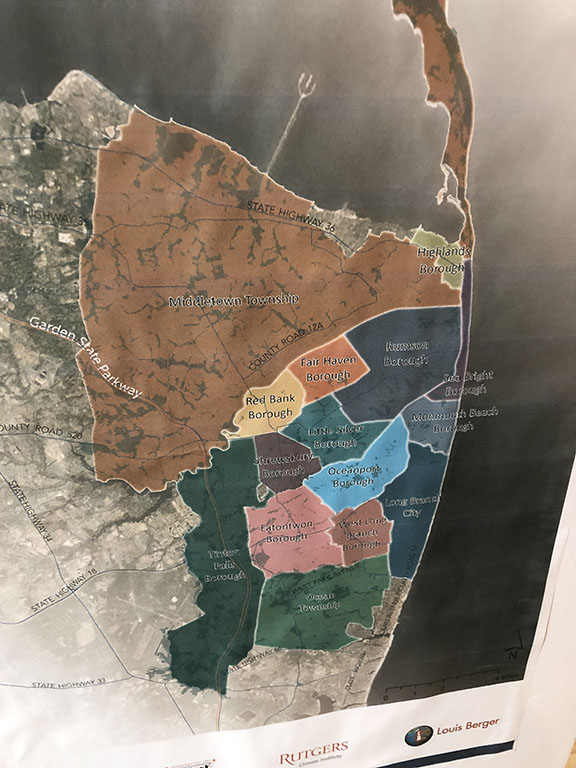By Philip Sean Curran
A report by the state Department of Environmental Protection (DEP) will offer policy recommendations, both in the short and long term, for how to respond to future coastal flooding in the Two River region, in the face of rising sea levels and potential major storms in the coming decades.
The federally funded document will examine three scenarios, including moving away from so-called “vulnerable coastal areas,” and recommend steps government and other stakeholders in the region, like NJ Transit, can take to be more resilient. The public got to see the latest on the regional project, called The New Jersey Fostering Regional Adaptation through Municipal Economic Scenarios (NJ FRAMES), at an open house July 10 at the Middletown Arts Center.
Paid for with a roughly $900,000 grant from the National Oceanic and Atmospheric Administration, the project was launched in 2016. The Two Rivers Council of Mayors applied for the funding, with the state performing “the analysis and the planning” for the 15 communities, Monmouth Beach Mayor Sue Howard said.
The report that gets released at the end of 2019 will show how all layers of government will have a role to play. None of the recommendations for policy changes will be binding on the towns, however.
“Ultimately, it’ll create a plan, working with the representatives from the 15 towns and stakeholders and the public, for how they can take action or how they and the state, they and the county and they and the federal government can take action based on the threats that we’re seeing from sea level rise and future coastal events,” said Nicholas Angarone, bureau chief with the DEP’s office of climate resiliency and planning. “We’re providing them the options to make informed decisions.”

Part of the project looks at water levels, projected at different time frames through the century, of as much as 12 feet above the norm due to combined effects of sea level rise and bad storms. Data from a Rutgers University report projecting sea level rise is being used for the project.
“We are pretty damn sure, based on the science, based on carbon emissions and climate change, that sea level is going to rise,” Angarone said.
At the open house last week there were maps of the region for the different scenarios the project team has laid out for 2030, 2050 and 2100.
For 2030, in the “protecting our communities from the water” scenario, suggested steps call for raising bulkheads in north Rumson and closing seawall gaps in Sea Bright and Monmouth Beach, among other things. In some actions, towns can take steps on their own, but there are “things that have to be done at a regional scale,” Angarone said.
Some ideas call for the state Department of Transportation, local governments and the county to work on infrastructure projects, like raising sidewalks and roads.
At Naval Weapons Station Earle, a military installation in Monmouth County, the federal government spends about $100 million every 10 years to strengthen and repair the pier complex. But during Sandy, Earle suffered $50 million worth of damage.
“The Navy will take care of its own infrastructure,” said Dennis Blazak, community plans and liaison officer at the installation, at the open house. “We’ll always want to be ready to do the mission we have. But if we’re the only ones that do it and the community doesn’t also prepare, then we’ll just be an island in the stream.”
This October will mark the seventh anniversary of Super Storm Sandy hitting the state and devastating the coastal region of Monmouth County.
Sea Bright Mayor Dina Long, arguing that flooding is not “a singular problem” for her community, said she pushed for a multijurisdictional approach to the issue. She said flooding “affects all the towns along the Shrewsbury and Navesink rivers.”
“So we all need to be coordinating and working together,” she said.
The NJ FRAMES project was an outgrowth of the storm, as mayors decided to work collaboratively.
“This went from being a conversation that we were having at DEP and some environmental groups and some advocates were having and some towns, to being on the front page every day that people were looking to address,” Angarone said. “The 15 towns here have been very progressive in taking this action to start having what are ultimately difficult conversations.”
“None of this would have happened but for Super Storm Sandy,” Long said. “This started out as a desire to coordinate locally across municipal boundaries.”
Yet in a state where local control rules in municipal government, Long said she thought the challenge would be getting “local buy-in for the recommendations” in the report.
“We’ve been saying from the beginning water doesn’t respect a municipal boundary,” she said. “Whatever we do in one town has to be consistent to the next town to the next town. Otherwise, we’re just spinning our wheels.”
Howard said she favors an approach that was applied in Wayne, where a government program called Blue Acres was used to buy homes of willing sellers who live in flood-prone areas of that community.
“There should certainly be a strategy for areas that are at risk to be bought out by Blue Acres over time where needed,” she said. “We do not need to vacate the entire Jersey Shore and we certainly don’t want to. We don’t want to because we love our shore and also because it is an economic engine for tourism.”














